From endpoint to XDR: Operationalize SentinelOne data in Elastic Security
Strengthen your threat detection, investigation, and response by using Elastic Security to ingest SentinelOne endpoint data.

Many security teams struggle to detect and respond to threats due to fragmented visibility and siloed endpoint data. The rise of extended detection and response (XDR) was driven by the need to integrate endpoint insights with contextualized data from networks, cloud environments, and identity systems. While endpoint security tools provide critical visibility into endpoint threats, it represents only one piece of the puzzle. Endpoint data alone lacks the broader context needed to fully understand and mitigate threats across an organization’s entire attack surface.
True XDR requires a comprehensive approach — one that moves beyond isolated endpoint telemetry. Elastic Security addresses this challenge with AI-driven security analytics, delivering unified threat detection, investigation, and response without the need for yet another XDR tool. With Elastic, security teams gain a single platform that eliminates silos, reduces tool sprawl, and cuts unnecessary costs — providing a more efficient and holistic defense against modern cyber threats.
Through our integration with SentinelOne, Elastic Security operationalizes SentinelOne data alongside signals from network, identity, and cloud sources, offering a complete threat picture. By ingesting SentinelOne telemetry, especially via Cloud Funnel, into Elastic Security, organizations can gain deeper visibility and take decisive security actions with advanced analytics, AI-driven assistance, and robust response capabilities.
Elastic Security ingests and normalizes data from hundreds of sources, providing a unified view of threats. Backed by Elastic Security Labs’ threat research and machine learning, detection rules surface suspicious activity in real time. Elastic’s open, scalable ecosystem ensures defenders can correlate SentinelOne alerts with other data sources, accelerating investigations and response. With a unified approach to security operations, teams gain the context they need to detect and mitigate threats before they escalate.
Integrating SentinelOne endpoint data with Elastic Security
SentinelOne provides insightful endpoint telemetry, but combining it with Elastic Security takes its effectiveness to another level.
By integrating SentinelOne data into Elastic Security, organizations can transform endpoint data into part of a broader XDR strategy. This unification provides a single pane of glass where endpoint alerts sit alongside log data from networks, clouds, identity systems, and more. The result is centralized visibility across your entire attack surface, making it easier to spot complex, multi-stage attacks that might be missed if analysis remains siloed on the endpoint alone.
With all security events aggregated in Elastic, defenders can apply advanced analytics uniformly. Elastic’s detection engine can run prebuilt correlation rules and machine learning jobs on SentinelOne events just as it would on Elastic Security’s native endpoint data. Notably, Elastic’s own library of endpoint detection rules is compatible with SentinelOne’s Cloud Funnel data, meaning teams can immediately leverage Elastic’s curated ruleset on incoming SentinelOne alerts for an added layer of defense.
Learn more about SentinelOne integrations: SentinelOne and SentinelOne_CloudFunnel
Threat detection with Elastic's AI-driven security analytics
Ingesting SentinelOne Cloud Funnel data into Elastic Security provides the ability to activate Elastic’s extensive library of prebuilt detection rules, behavior analytics, and machine learning models. Security teams don’t need to build their own analytics from scratch — Elastic provides out-of-the-box coverage against a wide range of threats.
Elastic’s machine learning jobs can detect anomalies in SentinelOne telemetry, identifying suspicious behaviors even when traditional rule-based detections fall short. Analysts can also create custom rules tailored to their organization’s unique environment, ensuring SentinelOne alerts are enriched with additional security context. By leveraging Elastic’s open, extensible data model, security teams can apply unified detections across endpoints, networks, cloud workloads, and identity systems, enabling true cross-domain threat detection.
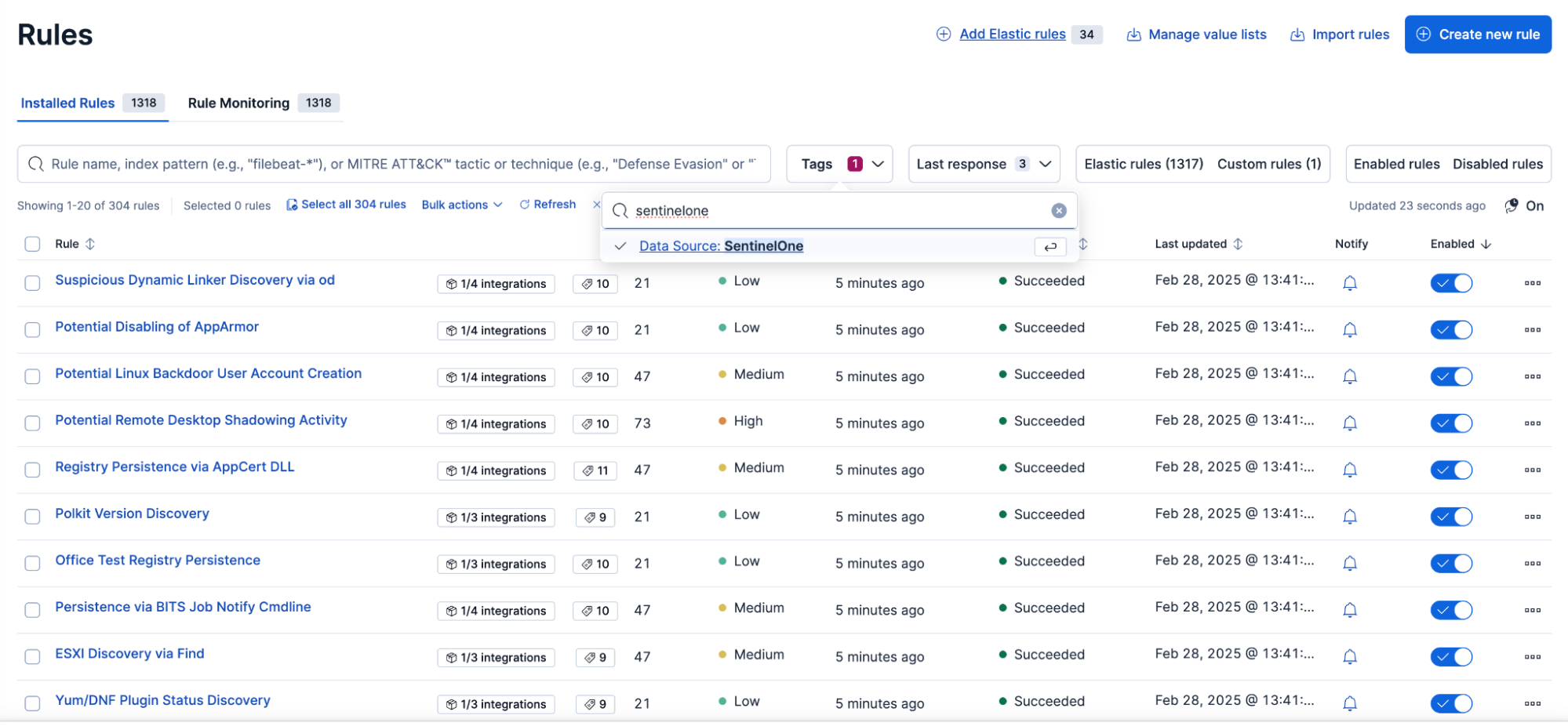
Investigate SentinelOne data with Elastic Security
Elastic AI Assistant: Accelerating investigations with contextual AI
Elastic AI Assistant is a transformative addition to the SOC toolkit, bringing generative AI directly into the analyst workflow. When SentinelOne data streams into Elastic, AI Assistant can dramatically speed up an analyst’s understanding and response by providing context, explanations, and recommendations in natural language.
Alert explainability
Elastic AI Assistant helps with alert triaging; it can parse and summarize SentinelOne alerts to clarify why an alert was triggered and its meaning. For instance, if SentinelOne generates an alert about a malicious process being executed in multiple endpoints, an analyst can ask the Assistant, “What is this alert telling me?” The Assistant might respond with a breakdown like the one below:
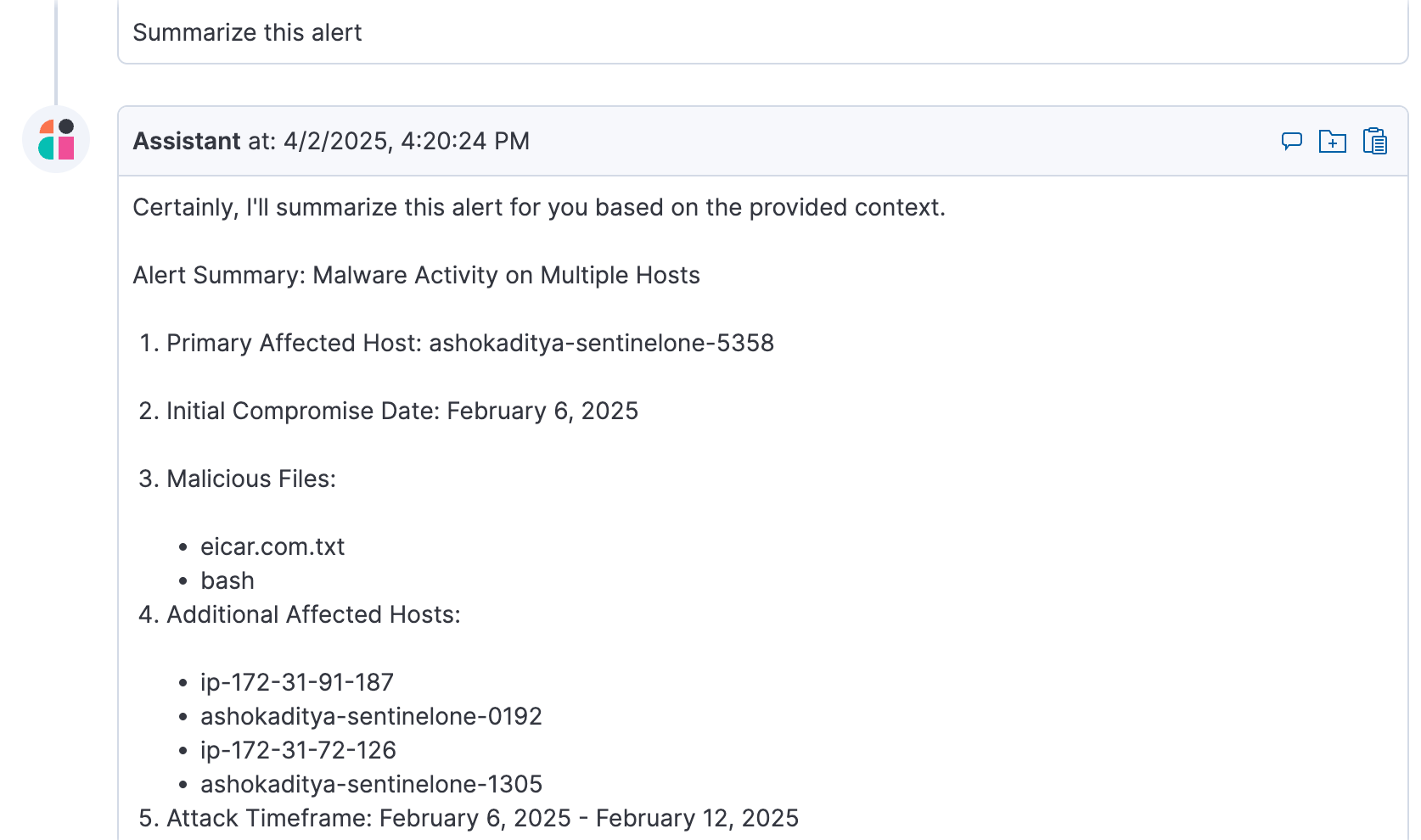
Remediation suggestions
Beyond explaining alerts, the Elastic AI Assistant can recommend next steps. In the scenario above, it might suggest actions such as isolating the affected host from the network, killing the suspicious process, and searching for the hash of the script across other endpoints. These AI-driven recommendations are context-aware — based on the alert details and historical responses to similar threats — and can guide analysts toward effective containment and eradication measures. AI Assistant essentially acts like an intelligent adviser, ensuring no time is lost figuring out how to respond when SentinelOne raises a high-severity alert.
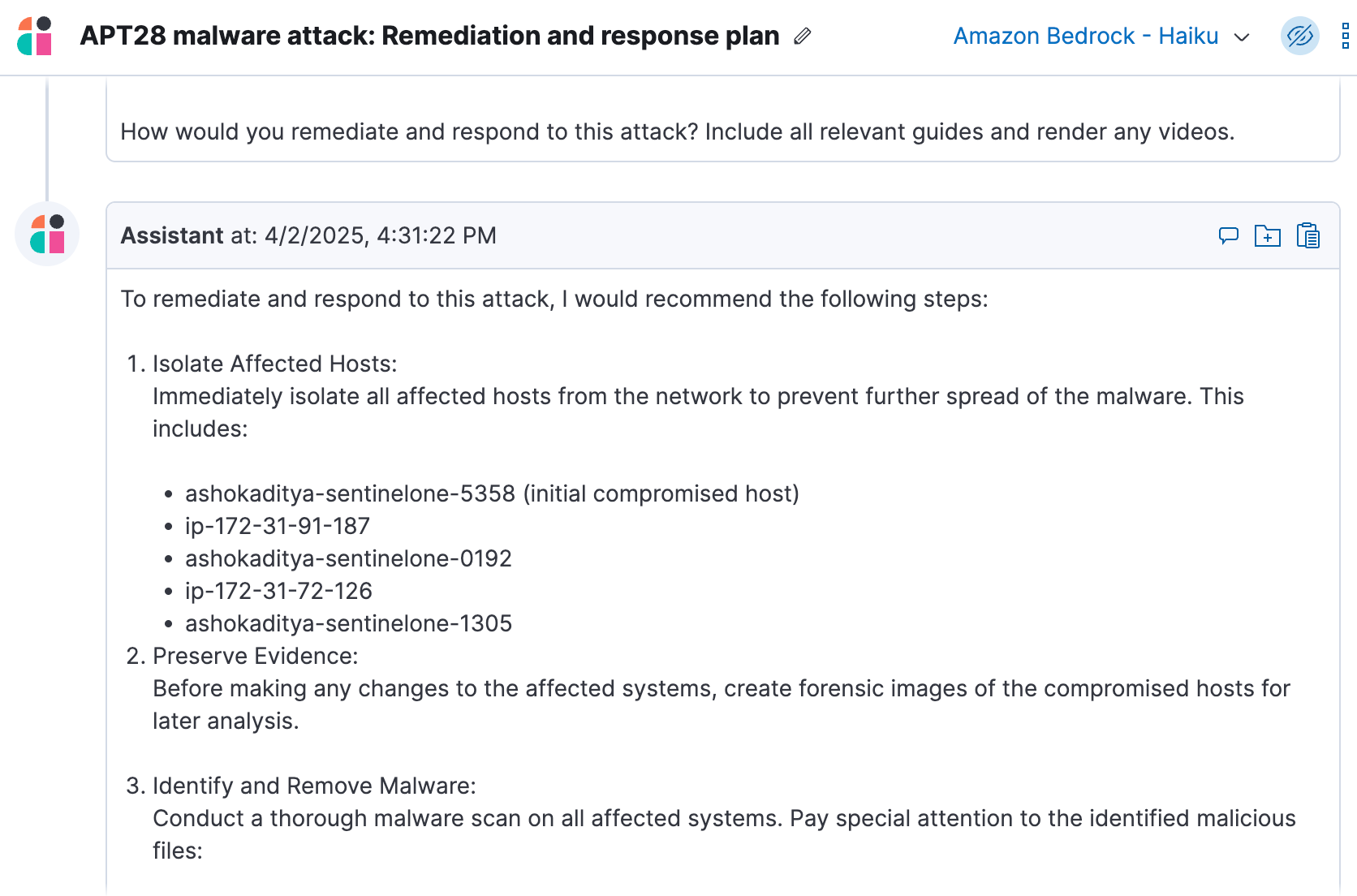
Custom knowledge source integration
Since Elastic Security 8.16, Elastic AI Assistant integrates with custom knowledge sources, such as threat intelligence feeds and internal playbooks, to provide answers tailored to organization’s specific security practices and the overall threat landscape. This means an analyst investigating a SentinelOne alert can ask questions in the context of their environment’s unique procedures or past incidents. For example, an analyst could query, “Have we seen this malware file in our environment before?” If the information exists in an internal incident report or threat intel feed indexed in Elastic, the AI Assistant will surface that reference.
Attack Discovery: Automated threat correlation and context
Investigating isolated alerts can lead to missing larger attack campaigns. Elastic Attack Discovery automatically correlates SentinelOne alerts with other security signals like cloud, network, and identity to reveal the bigger picture by using AI-driven security analytics and built-in threat intelligence. Instead of triaging one alert at a time, SOC analysts can get a clear, contextualized attack story mapped to MITRE ATT&CK tactics and techniques. This reduces the manual alert analysis effort and allows for a faster response with greater confidence.
For instance, using the previous ransomware example, Attack Discovery can assist an analyst in identifying the root cause of the incident by leveraging SentinelOne data but also network and identity events.
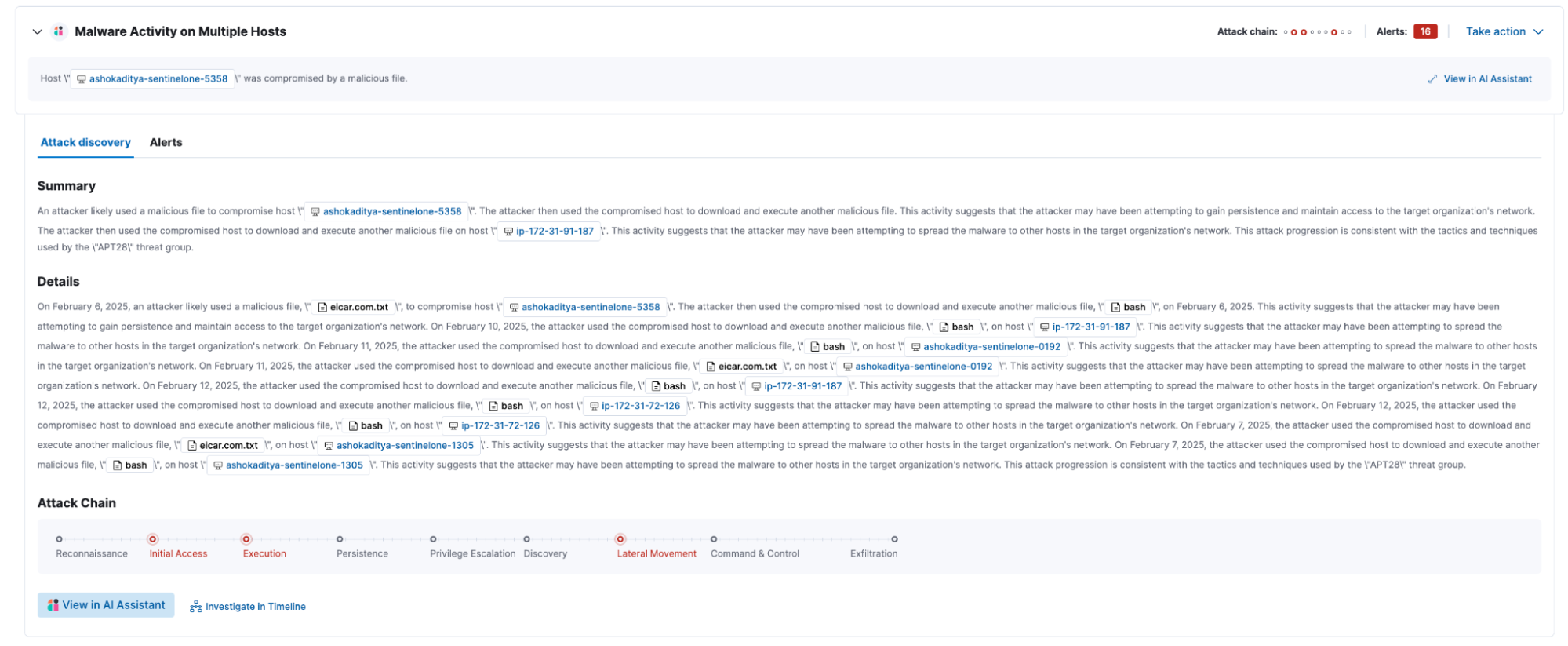
Interactive dashboards and visualizations
SentinelOne data in Elastic is instantly actionable through dashboards and visualization tools. Prebuilt Kibana dashboards provide insights into endpoint alerts, attack trends, and threat patterns mapped to MITRE ATT&CK framework.
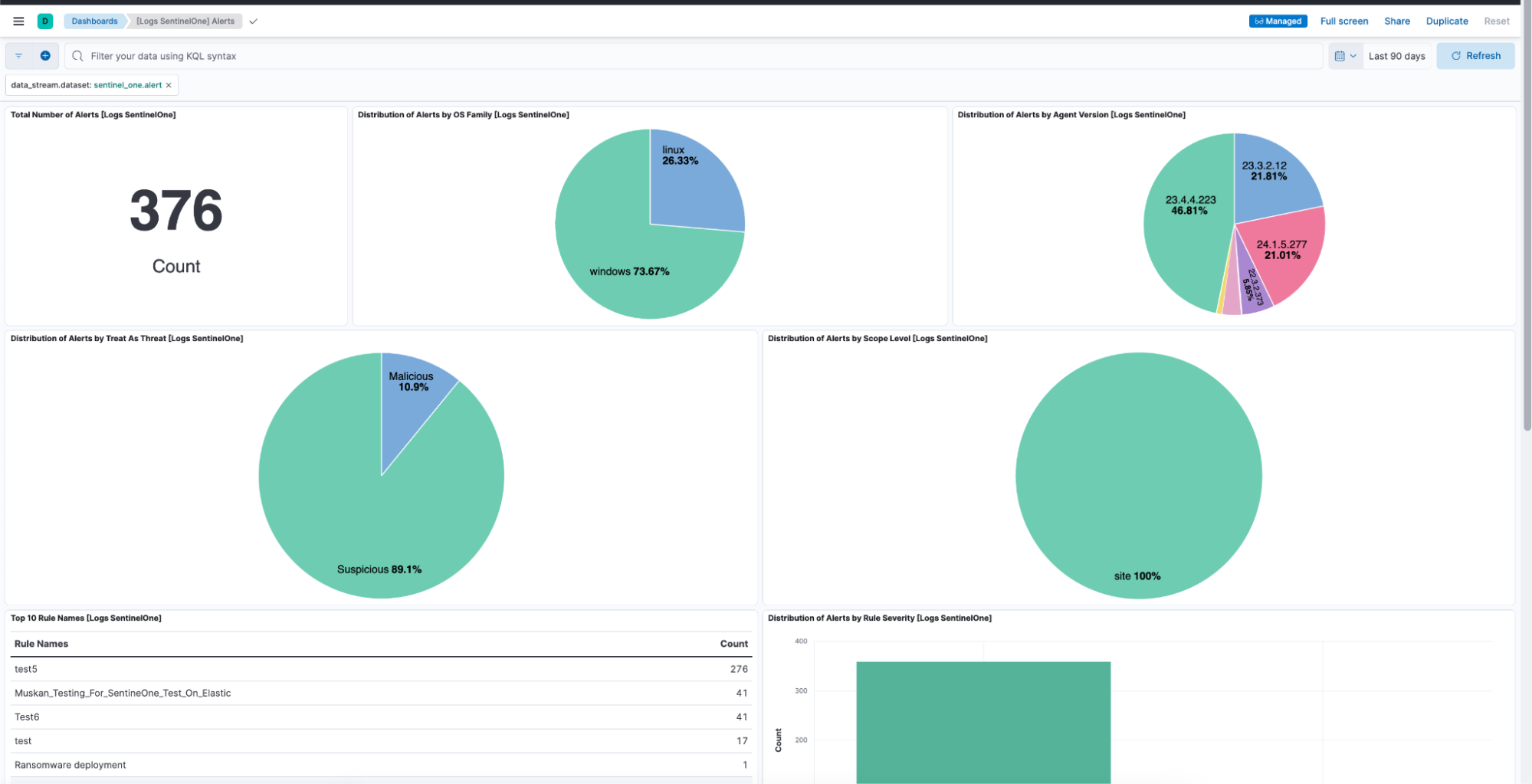
Analysts can drill down into specific alerts using the Analyzer to trace process activity or leverage Timelines to reconstruct incidents across multiple data sources. These tools bring SentinelOne data into a unified investigation workflow, improving detection, correlation, forensic analysis, and threat hunting.
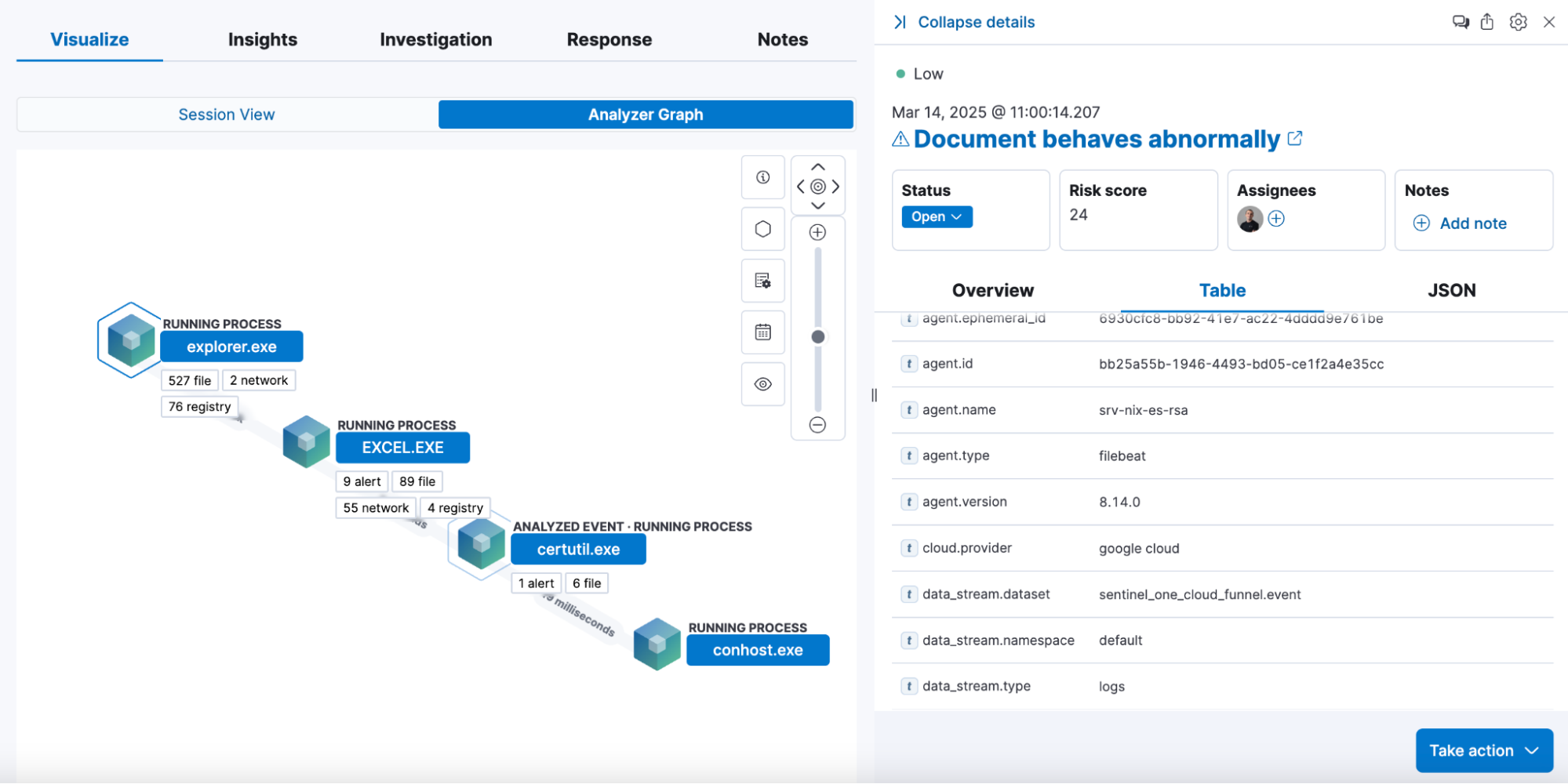

Taking action on SentinelOne alerts
Elastic Security enables bidirectional response actions for SentinelOne endpoints directly within the Elastic interface. Analysts can isolate compromised hosts, list and kill malicious processes, as well as collect files for forensic analysis — without switching between tools. This integration minimizes attacker dwell time and reduces mean time to respond (MTTR), ensuring swift containment of threats before they escalate.

Long-term visibility and advanced analytics
The more high-fidelity data you bring into Elastic, the stronger your security posture becomes. SentinelOne’s endpoint visibility combined with Elastic’s correlation and analytics unlocks a lot of value. However, it's important to also think of the long-term storage and access of that data. That’s where Elastic really shines.
Organizations can leverage Elastic’s powerful data storage and search capabilities. This strategic approach offers significant benefits, including cost-effective long-term data retention for compliance and historical analysis. With searchable snapshots, you can skip the manual rehydration, allowing you to historically search all of your data — SentinelOne and beyond — whenever you need it. Additionally, cross-cluster search enables a holistic security view by correlating data across multiple Elastic deployments.
Users can also leverage Elastic's Search AI Lake to apply advanced analytics and machine learning to SentinelOne data for deeper insights and automated threat detection. As described in previous paragraphs, Elastic's capabilities also extend to cross-platform threat detection, anomaly detection using machine learning, and proactive threat hunting with powerful queries and detection rules.
From all of the above, by centralizing SentinelOne data in Elastic, organizations can create a robust security data lake that not only provides powerful analytics but also serves as a long-term repository for valuable security information, moving beyond short-term analysis to a more comprehensive, strategic approach to security data management.
Reducing blindspots with Elastic Defend
Many organizations operate in hybrid environments where tools like SentinelOne are deployed on some endpoints but not all. Elastic Security provides a unified approach by allowing teams to deploy Elastic Defend on endpoints not covered by SentinelOne. This ensures consistent security monitoring, regardless of endpoint coverage, and enables defenders to analyze all endpoint telemetry within the same workflow.
By layering Elastic Defend with SentinelOne, security teams achieve full-spectrum endpoint protection while maintaining a single investigation and response platform. Whether ingesting SentinelOne alerts or collecting data from Elastic Defend agents, analysts can apply the same detection rules, correlation logic, and automated workflows, simplifying security operations across diverse environments.
Security that’s always one step ahead
Integrating SentinelOne endpoint data into Elastic Security yields a more powerful and cohesive security operation. The combination enables SOC teams to see the full picture of attacks, investigate incidents with AI assistance and automated correlation, and respond quickly from a single interface. Endpoint data alone is not enough; attackers pivot across endpoints, networks, and cloud services. A unified platform approach helps defenders even the odds by breaking down data silos and adding analytical muscle to endpoint telemetry.
For SOC leaders, this integration means the investment in endpoint security can go further: faster incident response, richer investigations, and the peace of mind that comes from having years of security data at your fingertips. Leveraging Elastic’s open, scalable ecosystem alongside SentinelOne’s endpoint capabilities, security teams can accelerate their threat detection and response workflows and stay ahead of adversaries in an ever-evolving threat landscape.
Get started with Elastic Security
Start your free trial of Elastic Security today and experience the benefits of integrating your SentinelOne endpoint data with Elastic Security. Gain deeper visibility, enhance threat detection capabilities, and improve your team's ability to respond to threats before they escalate.
The release and timing of any features or functionality described in this post remain at Elastic's sole discretion. Any features or functionality not currently available may not be delivered on time or at all.
In this blog post, we may have used or referred to third party generative AI tools, which are owned and operated by their respective owners. Elastic does not have any control over the third party tools and we have no responsibility or liability for their content, operation or use, nor for any loss or damage that may arise from your use of such tools. Please exercise caution when using AI tools with personal, sensitive or confidential information. Any data you submit may be used for AI training or other purposes. There is no guarantee that information you provide will be kept secure or confidential. You should familiarize yourself with the privacy practices and terms of use of any generative AI tools prior to use.
Elastic, Elasticsearch, ESRE, Elasticsearch Relevance Engine and associated marks are trademarks, logos or registered trademarks of Elasticsearch N.V. in the United States and other countries. All other company and product names are trademarks, logos or registered trademarks of their respective owners.

